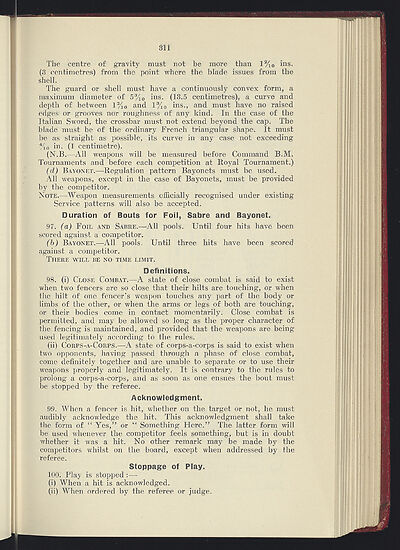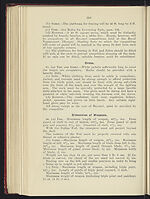1931
(325)
Download files
Complete book:
Individual page:
Thumbnail gallery: Grid view | List view

Mme.
qr
8
1
1
The centre of gravity must not be more than 1
2
/
lo
ins.
(3 centimetres) from the point where the blade issues from the
shell.
The guard or shell must have a continuously convex form, a
maximum diameter of
5M,
ins. (13.5 centimetres), a curve and
depth of between
12/lo
and
13/lo
ins., and must have no raised
edges or grooves nor roughness of any kind. In the case of the
Italian Sword, the crossbar must not extend beyond the cap. The
blade must be of the ordinary French triangular shape. It must
be as straight as possible, its curve in any case not exceeding
4 i o in. (1 centimetre).
(N.B.—All weapons will be measured before Command B.M.
Tournaments and before each competition at Royal Tournament.)
(d) BAYONET.—Regulation pattern Bayonets must be used.
All weapons, except in the case of Bayonets, must be provided
by the competitor.
NOTE.—Weapon measurements officially recognised under existing
Service patterns will also be accepted.
Duration of Bouts for Foil, Sabre and Bayonet.
97. (a) FOIL
AND SABRE
.—All pools. Until four hits have been
scored against a competitor.
(b) BAYONET.—All pools. Until three hits have been scored
against a competitor.
THERE WILL BE NO TIME LIMIT.
Definitions.
98. (i) CLOSE
COMBAT.
—A state of close combat is said to exist
when two fencers are so close that their hilts are touching, or when
the hilt of one fencer's weapon touches any part of the body or
limbs of the other, or when the arms or legs of both are touching,
or their bodies come in contact momentarily. Close combat is
permitted, and may be allowed so long as the proper character of
the fencing is maintained, and provided that the weapons are being
used legitimately according to the rules.
(ii)
CORPS-
A-
CORPS.
—A state of corps-a-corps is said to exist when
two opponents, having passed through a phase of close combat,
come definitely together and are unable to separate or to use their
weapons properly and legitimately. It is contrary to the rules to
prolong a corps-a-corps, and as soon as one ensues the bout must
be stopped by the referee.
Acknowledgment.
99. When a fencer is hit, whether on the target or not, he must
audibly acknowledge the hit. This acknowledgment shall take
the form of " Yes," or " Something Here." The latter form will
be used whenever the competitor feels something, but is in doubt
whether it was a hit. No other remark may be made by the
competitors whilst on the board, except when addressed by the
referee.
Stoppage of Play.
100. Play is stopped :—
(i) When a hit is acknowledged.
(ii) When ordered by the referee or judge.
qr
8
1
1
The centre of gravity must not be more than 1
2
/
lo
ins.
(3 centimetres) from the point where the blade issues from the
shell.
The guard or shell must have a continuously convex form, a
maximum diameter of
5M,
ins. (13.5 centimetres), a curve and
depth of between
12/lo
and
13/lo
ins., and must have no raised
edges or grooves nor roughness of any kind. In the case of the
Italian Sword, the crossbar must not extend beyond the cap. The
blade must be of the ordinary French triangular shape. It must
be as straight as possible, its curve in any case not exceeding
4 i o in. (1 centimetre).
(N.B.—All weapons will be measured before Command B.M.
Tournaments and before each competition at Royal Tournament.)
(d) BAYONET.—Regulation pattern Bayonets must be used.
All weapons, except in the case of Bayonets, must be provided
by the competitor.
NOTE.—Weapon measurements officially recognised under existing
Service patterns will also be accepted.
Duration of Bouts for Foil, Sabre and Bayonet.
97. (a) FOIL
AND SABRE
.—All pools. Until four hits have been
scored against a competitor.
(b) BAYONET.—All pools. Until three hits have been scored
against a competitor.
THERE WILL BE NO TIME LIMIT.
Definitions.
98. (i) CLOSE
COMBAT.
—A state of close combat is said to exist
when two fencers are so close that their hilts are touching, or when
the hilt of one fencer's weapon touches any part of the body or
limbs of the other, or when the arms or legs of both are touching,
or their bodies come in contact momentarily. Close combat is
permitted, and may be allowed so long as the proper character of
the fencing is maintained, and provided that the weapons are being
used legitimately according to the rules.
(ii)
CORPS-
A-
CORPS.
—A state of corps-a-corps is said to exist when
two opponents, having passed through a phase of close combat,
come definitely together and are unable to separate or to use their
weapons properly and legitimately. It is contrary to the rules to
prolong a corps-a-corps, and as soon as one ensues the bout must
be stopped by the referee.
Acknowledgment.
99. When a fencer is hit, whether on the target or not, he must
audibly acknowledge the hit. This acknowledgment shall take
the form of " Yes," or " Something Here." The latter form will
be used whenever the competitor feels something, but is in doubt
whether it was a hit. No other remark may be made by the
competitors whilst on the board, except when addressed by the
referee.
Stoppage of Play.
100. Play is stopped :—
(i) When a hit is acknowledged.
(ii) When ordered by the referee or judge.
Set display mode to:
![]() Universal Viewer |
Universal Viewer | ![]() Mirador |
Large image | Transcription
Mirador |
Large image | Transcription
| Games and sports in the army > 1931 > (325) |
|---|
| Permanent URL | https://digital.nls.uk/248675600 |
|---|
| Description | 'Games and Sports in the Army' was an annual publication produced by the British War Office between the 1930s and 1960s. This included the Second World War. It outlines the rules and regulations for games and sports played by members of the armed forces. It features names and photographs of team members, and examples of contemporary advertising. |
|---|---|
| Shelfmark | GWB.52 |

